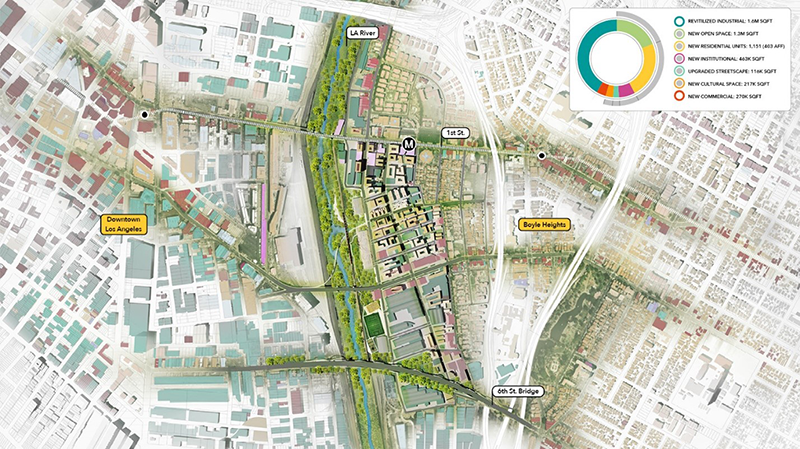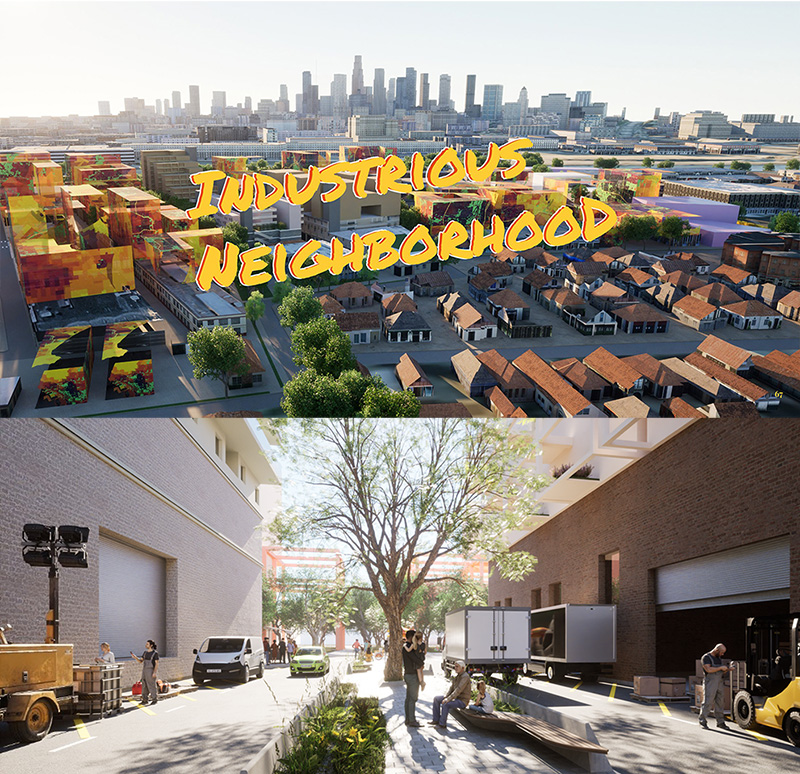Industrious Neighborhood: A Model for Equitable Urban Growth in the Age of Industrial Evolution
Rapidly densifying cities across the US face two seemingly disconnected challenges: the lack of affordable housing and a growing workforce mismatch. Boyle Heights, a historically immigrant neighborhood in Los Angeles, exemplifies these issues and presents an opportunity to address them: light-industrial zones. The “Industrious Neighborhood,” proposed in my thesis research, which won the Center’s Best Paper on Housing Prize last year, reimagines these light-industrial zones as productive living hubs that integrate housing and workforce development with emerging industries. In an era where urban growth often leads to the displacement of low-income residents, we must seek alternative models to promote inclusive growth.
What Is Urban Displacement, and Why Does It Matter as a Socioeconomic Issue?
The concepts of “root shock” and “mazeway disintegration” are integral to understanding urban displacement. These concepts highlight the profound psychological, social, and economic distress vulnerable communities experience when displaced. Dr. Mindy Thompson, a social psychiatrist at The New School, coined the term “root shock” to describe the trauma and disorientation people experience when uprooted from familiar environments. Displacement erodes social connections, leading to increased anxiety and depression, which further exacerbate the vulnerability of these communities.
Anthropologist Anthony Wallace, from the University of Pennsylvania, uses the term “mazeway disintegration” to describe how displacement breaks the mental frameworks, or “mazeways,” of everyday life (i.e., commute routes, paths to transit, groceries, worship centers, schools, laundry, etc.), causing distress when new mazeways must be created. As residents get displaced, neighborhoods break the trust, shared practices, and exchanges that sustain the local economy, often leading to business closures. This disruption ripples through the neighborhood and destabilizes socioeconomic networks. But as market forces incentivize displacement, new synergies can provide alternatives. Let’s look at the case of Boyle Heights through the lens of housing and workforce development.
Housing Crisis and Workforce Mismatch: The Case of Boyle Heights
Like many working-class neighborhoods across the US, Boyle Heights has been home to diverse migrant populations rich in character and culture. However, its central location and robust infrastructure have escalated land values and market shifts, increasing development pressures and housing costs. With approximately 70 percent of Boyle Heights residents renting their homes below market rate, both the community and its affordable housing stock are vulnerable to displacement.
In response to the longstanding Los Angeles housing shortage—now worsened by the recent fires—zoning updates such as the Boyle Heights Community Plan Implementation Ordinance (CPIO) aim to increase housing supply but lack effective measures to spur development while protecting tenants and preserving affordability. The ordinance upzones all residential parcels to medium-density housing and mandates the replacement of demolished affordable units within new projects. While this policy promotes housing construction and affordability, its implementation is unrealistic. High tenant relocation costs, affordability mandates, and escalating land and construction costs make these developments financially unfeasible. This deadlock leaves property owners at a development impasse, often leading to unscrupulous predatory practices targeting tenants unable to afford higher rents.
Another factor contributing to the housing crisis is the lack of access to high-quality jobs. In this rapidly evolving job market, many cities like Los Angeles face a critical workforce challenge: a mismatch between the skills industries need and the skills employees have. While Los Angeles boasts a thriving middle-skill job market (jobs requiring more education than high school but less than a four-year college degree) in healthcare, logistics, media production, and entertainment, many residents lack the skills needed to fill these roles. Census data underscores this disparity, revealing that only about 10 percent of Boyle Heights residents have a bachelor’s degree, highlighting the need for accessible education and vocational training.
If upzoning strategies on existing residential parcels prove unfeasible and the workforce lacks the skills to fill job vacancies, we need a more proactive systems-thinking approach.
Industrious Neighborhood site plan illustrating a reactivated industrial area with new residential units, institutional facilities, open spaces, commercial zones, and cultural amenities.
Reimagining Industrial Zones: The Industrious Neighborhood
With the decline of American manufacturing, single-use industrial zones are ripe for evolution. Euclidean zoning—a century-old system stemming from a 1926 Supreme Court ruling in Euclid, Ohio, which granted local governments the authority to segregate land uses—isolated residential parcels from daily amenities and constrained urban vitality. Today, many cities are shifting toward mixed-use districts and transit-oriented corridors to increase walkability, reduce car dependency, and promote sustainability. However, industrial zones remain a challenge. Most cities have experienced a zero-sum game, where impatient capital replaces warehouses with market-rate housing, displacing the remaining workforce and eliminating opportunities for emerging industries.
The Industrious Neighborhood provides an opportunity to challenge outdated planning practices and looks at global strategies to reactivate light-industrial zones.
Hybrid Streets: Access for Urban Vitality
By reorganizing vehicular circulation to separate residential access from industrial operations—such as rerouting trucks through designated collector streets and alleys—local streets can redistribute their space to become more accessible pedestrian- and bike-friendly places. In Barcelona, for example, Rambla-style medians channel people-powered mobility through the center of the street, improving street safety, encouraging multigenerational activity, and sparking neighborhood vitality—all while maintaining industrial operations.
Hybrid Buildings: Adaptive Reuse for Urban Regeneration
In medium-density areas around the world, small and medium-sized enterprises (SMEs)—often born out of necessity and supplying neighborhood needs—thrive on the ground floors of buildings and in home garages, activating the local economy and strengthening community ties. With a shift from the manufacturing of goods to the manufacturing of ideas, myriad ground-level SMEs can coexist with new residences on top, regenerating new urban productivity from underused industrial areas.
Top: Section of a Rambla-style hybrid street designed for multimodal circulation. Bottom: Section of a transitional street linking to major urban amenities, in this case, the Los Angeles River.
Hybrid Neighborhoods: Productive Living Hubs for Socioeconomic Mobility
An evolution from industrial to hybrid infrastructure can disrupt the corporate homogenization of contemporary mixed-use developments while promoting entrepreneurship within microeconomies. To support equitable development, new hybrid zoning can incentivize public-private partnerships with emerging industries to achieve two main goals: integrating workforce training facilities and ensuring sufficient residential density to make affordable and workforce housing financially feasible.
Renowned urban theorist and activist Jane Jacobs, in her seminal book The Death and Life of Great American Cities, praised the urban theater of the “sidewalk ballet,” where residents, workers, seniors, and children seamlessly choreograph their daily routines to “reinforce each other and compose an orderly whole.” This hybrid performance is the promise of the Industrious Neighborhood: to set the stage for a cohesive urbanity and a productive community within the kaleidoscopic backdrop of neighborhoods like Boyle Heights. By leveraging its robust infrastructure, upgrading the spatial capacity for workforce development and emerging industries, and rezoning to include residential density, the Industrious Neighborhood can become a model for equitable growth and socioeconomic mobility within prime real estate.
Top: Aerial view of Downtown Los Angeles with the Industrious Neighborhood, featuring dynamic residential buildings atop warehouses. Bottom: Street view of the Industrious Neighborhood with a landscaped median surrounded by active industrial spaces.




